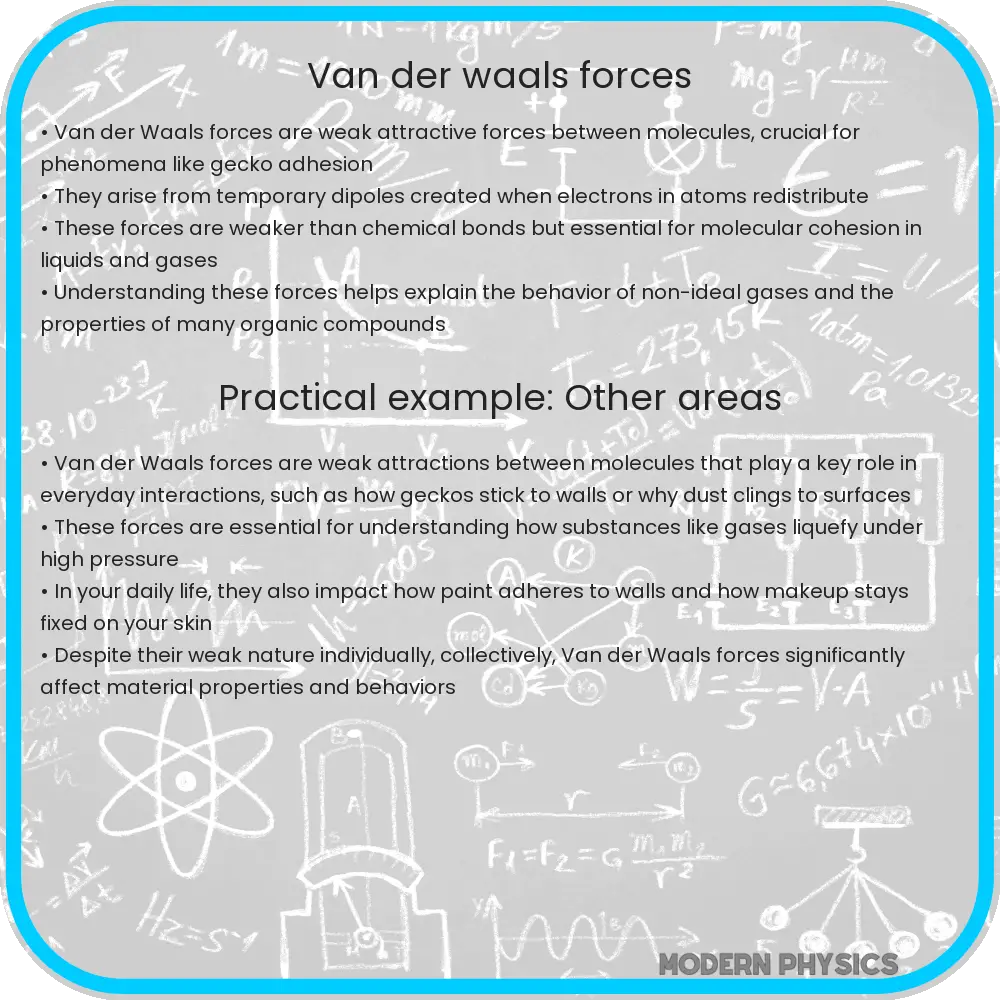Learn about Van der Waals forces, the intermolecular attractions critical to chemistry and physics, named after Johannes Diderik van der Waals, detailing their types and mechanisms.

Understanding Van der Waals Forces
Van der Waals forces are a variety of intermolecular forces that play a crucial role in the understanding of chemistry and physics. Named after Dutch physicist Johannes Diderik van der Waals, these forces describe the attraction between molecules, which occurs due to variations in the distribution of electron clouds that surround their nuclei.
Types of Van der Waals Forces
There are three primary types of Van der Waals forces, each defined by the specific characteristics and mechanisms through which molecular interactions occur:
- London Dispersion Forces: This is the weakest form of Van der Waals forces but significant as it is universal and affects all molecules. These forces originate from temporary or induced dipole interactions when the electron locations within atoms or molecules are momentarily asymmetric.
- Dipole-Dipole Interactions: This type manifests in molecules that have permanent dipoles (polar molecules). Here, the positive end of one molecule attracts the negative end of another molecule.
- Hydrogen Bonds: Although often considered a separate category, hydrogen bonds are a strong type of dipole-dipole interaction. They occur when hydrogen is bound to a highly electronegative atom such as nitrogen, oxygen, or fluorine, making it act almost as a bare proton which attracts neighboring electronegative atoms more forcefully.
Essential Principles Behind Van der Waals Forces
The core idea behind Van der Waals Forces is the concept of polarization and induced dipole moment. In even the most symmetrical molecules, fluctuations can momentarily create dipoles (regions with a separation of charge). This fleeting state can then induce a dipole in a neighboring molecule, leading to attraction, a property exhibited by the London Dispersion Forces.
On the other hand, molecules with permanent dipoles demonstrate an inherent separation of charge. For instance, in water (H2O), the oxygen atom holds a partial negative charge, while the hydrogen atoms are slightly positive. This distinction allows these molecules to align themselves beneficially with other polar molecules, resulting in dipole-dipole interactions.
Mechanism Analysis
Visualization of Van der Waals Forces can be characterized by considering the potential energy (\(V(r)\)) between molecules as a function of their separation \(r\). Generally, the potential energy associated with Van der Waals interactions can be represented as follows:
\[ V(r) = -\frac{C}{r^6} \]
Here, \( C \) is a constant that depicts the strength of the interaction which depends on the properties of the molecules involved, and the term \(-\frac{1}{r^6}\) explicates the rapid decrease of the attractive potential with increased distance between molecules. This equation gives us an insight into the inverse sixth power law that governs the interaction intensity distance relationship for dispersion forces, illustrating the extreme distance sensitivity of these interactions.
These fundamental principles lay the groundwork for the extensive role Van der Waals forces play in nature, as detailed in the following sections discussing their applications and real-world significance.
Applications of Van der Waals Forces
Van der Waals forces are pivotal in a myriad of everyday phenomena and technologies. Some key applications include:
- Adhesion: Certain animals, like geckos, exploit Van der Waals forces for climbing smooth surfaces. The microscopic structures in their feet provide the necessary surface area to maximize these forces, allowing strong adhesive capabilities without the use of liquids or suction.
- Molecular Assembly: Van der Waals forces drive the self-assembly of molecular structures in nanotechnology. This is crucial for the development of new materials and devices at nanometric scales.
- Condensation and Boiling: These forces also play a role in the phase transitions of matter, such as condensation and boiling. The interactions between molecules contribute to changes in physical state, impacting various industrial and natural processes.
Conclusion
Understanding Van der Waals forces allows us to grasp the intricate dance that occurs at the molecular level. From the stickiness of a gecko’s foot to the formation of a raindrop, these forces are fundamental in shaping our world. By studying how these interactions manifest and operate, scientists and engineers can design better materials and technologies, enhancing everything from medicinal delivery systems to innovative adhesive products.
Although often overlooked, Van der Waals forces influence daily life and advanced scientific research. They remind us that powerful outcomes often arise from subtle forces that operate silently behind the scenes.
